University of Pennsylvania
The University of Pennsylvania (Penn or UPenn) is a private Ivy League research university in Philadelphia. The University claims a founding date of 1740[note 1] and is one of the nine colonial colleges chartered prior to the U.S. Declaration of Independence. Benjamin Franklin, Penn's founder and first president, advocated an educational program that trained leaders in commerce, government, and public service, similar to a modern liberal arts curriculum.[10]
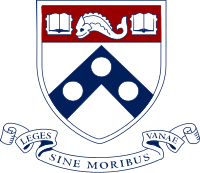 | |
| Latin: Universitas Pennsylvaniensis | |
| Motto | Leges sine moribus vanae (Latin) |
|---|---|
Motto in English | Laws without morals are useless |
| Type | Private research university |
| Established | November 14, 1740[note 1] |
| Founder | Benjamin Franklin |
| Endowment | $14.65 billion (2019)[4] |
| Budget | $3.5 billion (2020)[5] |
| President | Amy Gutmann |
| Provost | Wendell Pritchett |
| Board Chairman | David L. Cohen[6] |
Academic staff | 4,793 (2018)[7] |
| Students | 22,432 (Fall 2019)[8] |
| Undergraduates | 10,019 (Fall 2019)[8] |
| Postgraduates | 12,413 (Fall 2019)[8] |
| Location | , , United States |
| Campus | Urban, 1,085 acres (4.39 km2) total: 299 acres (1.21 km2), University City campus; 694 acres (2.81 km2), New Bolton Center; 92 acres (0.37 km2), Morris Arboretum |
| Colors | Penn Red and Penn Blue[9] |
| Athletics | NCAA Division I – Ivy League Philadelphia Big 5 City 6 |
| Nickname | Quakers |
| Affiliations | AAU COFHE NAICU 568 Group URA |
| Website | upenn |
 | |
Penn has four undergraduate schools as well as twelve graduate and professional schools. Among its graduate and professional schools are the first school of medicine in North America (Perelman School of Medicine, 1765) and the first collegiate business school (Wharton School, 1881). Penn is also home to the first "student union" building and organization (Houston Hall, 1896), the first double-decker college football stadium (Franklin Field, 1922),[11][12] and Morris Arboretum, the official arboretum of the Commonwealth of Pennsylvania. In 2019, the university had an endowment of $14.65 billion, the sixth-largest endowment of all colleges in the United States,[4] as well as a research budget of $1.02 billion.[7] The university's athletics program, the Quakers, fields varsity teams in 33 sports as a member of the NCAA Division I Ivy League conference.
As of 2018, distinguished alumni include 14 foreign heads of state, 64 billionaires,[13] 3 U.S. Supreme Court justices, 32 U.S. Senators from 16 states, 46 U.S. Governors from 24 states, Puerto Rico and American Samoa, 163 members of the U.S. House of Representatives from 21 states, 8 signers of the U.S. Declaration of Independence, 12 signers of the U.S. Constitution, 24 members of the Continental Congress from 7 states, and two presidents of the United States, including the current U.S. President, Donald Trump.[14][15][16] Other notable alumni include 29 Rhodes Scholars,[17] 15 Marshall Scholars,[18] 16 Pulitzer Prize winners, and 48 Fulbright Scholars.[19]
Among other distinguished alumni are the founders of eight medical schools including New York University School of Medicine, and current or past presidents of over one hundred universities and colleges including Harvard University, University of Pennsylvania, Princeton University, Cornell University, University of California system, University of Texas system, Carnegie Mellon University, Northwestern University, Bowdoin College and Williams College.
As of October 2019, 36 Nobel laureates, 169 Guggenheim Fellows, 80 members of the American Academy of Arts and Sciences, and many Fortune 500 CEOs have been affiliated with the university.[20][21][22] Penn has the highest number of undergraduate alumni billionaires of any school in the United States.[23][24]
History

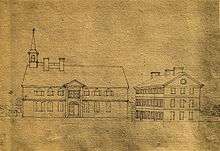


The University of Pennsylvania considers itself the fourth-oldest institution of higher education in the United States, though this is contested by Princeton and Columbia Universities.[note 2] The university also considers itself as the first university in the United States with both undergraduate and graduate studies.
In 1740, a group of Philadelphians joined together to erect a great preaching hall for the traveling evangelist George Whitefield, who toured the American colonies delivering open-air sermons. The building was designed and built by Edmund Woolley and was the largest building in the city at the time, drawing thousands of people the first time it was preached in.[36]:26 It was initially planned to serve as a charity school as well, but a lack of funds forced plans for the chapel and school to be suspended. According to Franklin's autobiography, it was in 1743 when he first had the idea to establish an academy, "thinking the Rev. Richard Peters a fit person to superintend such an institution". However, Peters declined a casual inquiry from Franklin and nothing further was done for another six years.[36]:30 In the fall of 1749, now more eager to create a school to educate future generations, Benjamin Franklin circulated a pamphlet titled "Proposals Relating to the Education of Youth in Pensilvania", his vision for what he called a "Public Academy of Philadelphia".[37] Unlike the other colonial colleges that existed in 1749—Harvard, William & Mary, Yale, and Princeton—Franklin's new school would not focus merely on education for the clergy. He advocated an innovative concept of higher education, one which would teach both the ornamental knowledge of the arts and the practical skills necessary for making a living and doing public service. The proposed program of study could have become the nation's first modern liberal arts curriculum, although it was never implemented because Anglican priest William Smith (1727-1803), who became the first provost, and other trustees strongly preferred the traditional curriculum.[10][38]
Franklin assembled a board of trustees from among the leading citizens of Philadelphia, the first such non-sectarian board in America. At the first meeting of the 24 members of the Board of Trustees (November 13, 1749), the issue of where to locate the school was a prime concern. Although a lot across Sixth Street from the old Pennsylvania State House (later renamed and famously known since 1776 as "Independence Hall"), was offered without cost by James Logan, its owner, the Trustees realized that the building erected in 1740, which was still vacant, would be an even better site. The original sponsors of the dormant building still owed considerable construction debts and asked Franklin's group to assume their debts and, accordingly, their inactive trusts. On February 1, 1750, the new board took over the building and trusts of the old board. On August 13, 1751, the "Academy of Philadelphia", using the great hall at 4th and Arch Streets, took in its first secondary students. A charity school also was chartered on July 13, 1753,[39]:12 by the intentions of the original "New Building" donors, although it lasted only a few years. On June 16, 1755, the "College of Philadelphia" was chartered, paving the way for the addition of undergraduate instruction.[39]:13 All three schools shared the same Board of Trustees and were considered to be part of the same institution.[40] The first commencement exercises were held on May 17, 1757.[39]:14
_1755.jpg)

The institution of higher learning was known as the College of Philadelphia from 1755 to 1779. In 1779, not trusting then-provost the Reverend William Smith's "Loyalist" tendencies, the revolutionary State Legislature created a University of the State of Pennsylvania.[40] The result was a schism, with Smith continuing to operate an attenuated version of the College of Philadelphia. In 1791, the Legislature issued a new charter, merging the two institutions into a new University of Pennsylvania with twelve men from each institution on the new Board of Trustees.[40]
Penn has three claims to being the first university in the United States, according to university archives director Mark Frazier Lloyd: the 1765 founding of the first medical school in America[41] made Penn the first institution to offer both "undergraduate" and professional education; the 1779 charter made it the first American institution of higher learning to take the name of "University"; and existing colleges were established as seminaries (although, as detailed earlier, Penn adopted a traditional seminary curriculum as well).[42]
After being located in downtown Philadelphia for more than a century, the campus was moved across the Schuylkill River to property purchased from the Blockley Almshouse in West Philadelphia in 1872, where it has since remained in an area now known as University City. Although Penn began operating as an academy or secondary school in 1751 and obtained its collegiate charter in 1755, it initially designated 1750 as its founding date; this is the year that appears on the first iteration of the university seal. Sometime later in its early history, Penn began to consider 1749 as its founding date and this year was referenced for over a century, including at the centennial celebration in 1849.[43] In 1899, the board of trustees voted to adjust the founding date earlier again, this time to 1740, the date of "the creation of the earliest of the many educational trusts the University has taken upon itself".[44] The board of trustees voted in response to a three-year campaign by Penn's General Alumni Society to retroactively revise the university's founding date to appear older than Princeton University, which had been chartered in 1746.[45]
Early campuses
The Academy of Philadelphia, a secondary school for boys, began operations in 1751 in an unused church building at 4th and Arch Streets which had sat unfinished and dormant for over a decade. Upon receiving a collegiate charter in 1755, the first classes for the College of Philadelphia were taught in the same building, in many cases to the same boys who had already graduated from The Academy of Philadelphia. In 1801, the University moved to the unused Presidential Mansion at 9th and Market Streets, a building that both George Washington and John Adams had declined to occupy while Philadelphia was the temporary national capital.[39] Classes were held in the mansion until 1829 when it was demolished. Architect William Strickland designed twin buildings on the same site, College Hall and Medical Hall (both 1829–1830), which formed the core of the Ninth Street Campus until Penn's move to West Philadelphia in the 1870s.
Residential university

From its founding until construction of the Quadrangle Dormitories (University of Pennsylvania), which started construction in 1895, the student body did not live in University owned housing as, with minor exceptions, there was none. Indeed a significant portion of the undergraduate population commuted from Delaware Valley and a large number of students resided in the Philadelphia area.[46] The Medical School (with roughly half the students) was a significant exception to this trend, as it attracted a more geographically diverse population of students. For example, as of the mid-1850s, over half of the population of the Medical School was from the southern part of the United States.[47][48]
By 1931, first-year students were required to live in the Quadrangle unless they received official permission to live with their families or other relatives.[47] However, throughout this period and into the early post-World War II period, the school continued to have a large commuting population.[49] As an example, into the late 1940s, two-thirds of Penn women students were commuters.[50]
After World War II, Penn began a capital spending program to overhaul its campus, especially student housing. A large number of students migrating to universities under the GI Bill, and the resultant increase in Penn's student population, highlighted that Penn had outgrown previous expansions, which ended during the Depression-era. Nonetheless, in addition to a significant student population from the Delaware Valley, Penn attracted international students and students from most of the 50 states as early as the 1960s.[51] Referring to the developments of this time period, Penn Trustee Paul Miller remarked, "[t]he bricks-and-mortar Capital Campaign of the Sixties...built the facilities that turned Penn from a commuter school to a residential one...."[52] By 1961, 79% of male undergraduates and 57% of female undergraduates lived on campus.[53]
From 1930 to 1966, there were 54 documented Rowbottom riots, a student tradition of rioting which included everything from car smashing to panty raids.[54] After 1966, there were five more instances of "Rowbottoms", the latest occurring in 1980.[54]
In 1965, Penn students learned that the university was sponsoring research projects for the United States' chemical and biological weapons program.[55] According to Herman and Rutman, the revelation that "CB Projects Spicerack and Summit were directly connected with U.S. military activities in Southeast Asia", caused students to petition Penn president Gaylord Harnwell to halt the program, citing the project as being "immoral, inhuman, illegal, and unbefitting of an academic institution".[55] Members of the faculty believed that an academic university should not be performing classified research and voted to re-examine the University agency which was responsible for the project on November 4, 1965.[55]
In 1984, the Head Lab at the University of Pennsylvania was raided by members of the Animal Liberation Front.[56] Sixty hours' worth of video footage was stolen from the lab.[57] The video footage was released to PETA who edited the tapes and created the documentary Unnecessary Fuss.[57] As a result of an investigation called by the Office for Protection from Research Risks, the chief veterinarian was fired and the Head Lab was closed.[57]
The school gained notoriety in 1993 for the water buffalo incident in which a student who told a group of black students to "shut up, you water buffalo" was charged with violating the university's racial harassment policy.[58]
Educational innovations
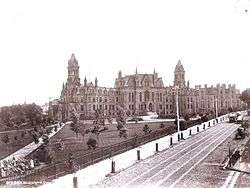
Penn's educational innovations include the nation's first medical school in 1765; the first university teaching hospital in 1874; the Wharton School, the world's first collegiate business school, in 1881; the first American student union building, Houston Hall, in 1896;[59] the country's second school of veterinary medicine; and the home of ENIAC, the world's first electronic, large-scale, general-purpose digital computer in 1946. Penn is also home to the oldest continuously functioning psychology department in North America and is where the American Medical Association was founded.[60][61] In 1921, Penn was also the first university to award a PhD to an African-American woman, Sadie Tanner Mossell Alexander (in economics).[62]
Motto
Penn's motto is based on a line from Horace's III.24 (Book 3, Ode 24), quid leges sine moribus vanae proficiunt? ("of what avail empty laws without [good] morals?"). From 1756 to 1898, the motto read Sine Moribus Vanae. When it was pointed out that the motto could be translated as "Loose women without morals", the university quickly changed the motto to literae sine moribus vanae ("Letters without morals [are] useless"). In 1932, all elements of the seal were revised. As part of the redesign, it was decided that the new motto "mutilated" Horace, and it was changed to its present wording, Leges Sine Moribus Vanae ("Laws without morals [are] useless").[63]
Seal
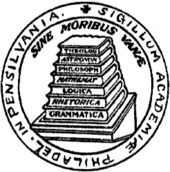
The official seal of the Trustees of the University of Pennsylvania serves as the signature and symbol of authenticity on documents issued by the corporation.[64] A request for one was first recorded in a meeting of the trustees in 1753 during which some of the Trustees "desired to get a Common Seal engraved for the Use of [the] Corporation". However, it was not until a meeting in 1756 that "a public Seal for the College with a proper device and Motto" was requested to be engraved in silver.[65] The most recent design, a modified version of the original seal, was approved in 1932, adopted a year later and is still used for much of the same purposes as the original.[64]
The outer ring of the current seal is inscribed with "Universitas Pennsylvaniensis", the Latin name of the University of Pennsylvania. The inside contains seven stacked books on a desk with the titles of subjects of the trivium and a modified quadrivium, components of a classical education: Theolog[ia], Astronom[ia], Philosoph[ia], Mathemat[ica], Logica, Rhetorica and Grammatica. Between the books and the outer ring is the Latin motto of the University, "Leges Sine Moribus Vanae".[64]
Campus
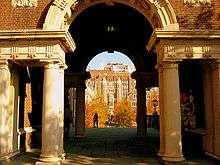
Much of Penn's architecture was designed by the Cope and Stewardson firm (same architects who designed a large part of Washington University in St. Louis and Princeton University) known for having combined the Gothic architecture of the University of Oxford and the University of Cambridge with the local landscape to establish the Collegiate Gothic style. The present core campus covers over 299 acres (121 ha) in a contiguous area of West Philadelphia's University City section, whereas the older heart of the campus comprises the University of Pennsylvania Campus Historic District. All of Penn's schools and most of its research institutes are located on this campus. The surrounding neighborhood includes several restaurants and pubs, a large upscale grocery store and a movie theater on the western edge of campus.
The campus has several notable art installations. The Covenant, better known to the student body as "The Tampons",[66] is a large red structure located on Locust Walk between the high rise residences. It was installed in 1975 and is made of rolled sheets of milled steel. A larger-than-life white button, known as The Button, is another popular sculpture. It sits at the south entrance of Van Pelt Library and has button holes large enough to stand in. Penn also has a replica of the Love sculpture, part of a series created by Robert Indiana. It is a painted aluminum sculpture and was installed in 1998.
The Module 6 Utility Plant and Garage at Penn was designed by BLT Architects and completed in 1995. Module 6 is located at 38th and Walnut and includes spaces for 627 vehicles, 9,000 sq ft (840 m2) of storefront retail operations, a 9,500-ton chiller module and corresponding extension of the campus chilled water loop and a 4,000-ton ice storage facility.[67]
In 2007, Penn acquired about 35 acres (14 ha) between the campus and the Schuylkill River (the former site of the Philadelphia Civic Center and a nearby 24-acre (9.7 ha) site owned by the United States Postal Service). Dubbed the Postal Lands, the site extends from Market Street on the north to Penn's Bower Field on the south, including the former main regional U.S. Postal Building at 30th and Market Streets, now the regional office for the U.S. Internal Revenue Service. Over the next decade, the site became the home to educational, research, biomedical, and mixed-use facilities. The first phase, comprising a park and athletic facilities, opened in the fall of 2011. Penn also plans new connections between the campus and the city, including a pedestrian bridge. In 2010, in its first significant expansion across the Schuylkill River, Penn purchased 23 acres at the northwest corner of 34th Street and Grays Ferry Avenue from DuPont for storage and office space.
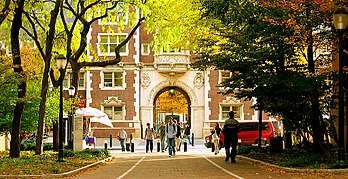
In September 2011, Penn completed the construction of the $46.5 million 24-acre (97,000 m2) Penn Park, which features passive and active recreation and athletic components framed and subdivided by canopy trees, lawns, and meadows. It is located east of the Highline Green and stretches from Walnut Street to South Streets. The University also owns the 92-acre (37 ha) Morris Arboretum in Chestnut Hill in northwestern Philadelphia, the official arboretum of the state of Pennsylvania. Penn also owns the 687-acre (278 ha) New Bolton Center, the research and large-animal health care center of its Veterinary School. Located near Kennett Square, New Bolton Center received nationwide media attention when Kentucky Derby winner Barbaro underwent surgery at its Widener Hospital for injuries suffered while running in the Preakness Stakes.
Penn borders Drexel University and is near the University of the Sciences in Philadelphia. The renowned cancer research center Wistar Institute is also located on campus. In 2014, a new 7-story glass and steel building was completed next to the Institute's historic 117-year-old brick building further expanding collaboration between the university and the Wistar Institute.[68]
Libraries
Penn's library began in 1750 with a donation of books from cartographer Lewis Evans. Twelve years later, then-provost William Smith sailed to England to raise additional funds to increase the collection size. Benjamin Franklin was one of the Libraries' earliest donors and, as a Trustee, saw to it that funds were allocated for the purchase of texts from London, many of which are still part of the collection, more than 250 years later. It has grown into a system of 15 libraries (13 are on the contiguous campus) with 400 full-time equivalent (FTE) employees and a total operating budget of more than $48 million. The library system has 6.19 million book and serial volumes as well as 4.23 million microform items and 1.11 million e-books.[7] It subscribes to over 68,000 print serials and e-journals.[69]
Penn's libraries, with associated school or subject area: Annenberg (School of Communications), located in the Annenberg School; Biddle (Law), located in the Law School; Biomedical, located adjacent to the Robert Wood Johnson Pavilion of the Medical School; Chemistry, located in the 1973 Wing of the Chemistry Building; Dental Medicine; Engineering, located on the second floor of the Towne Building in the Engineering School; Fine Arts, located within the Fisher Fine Arts Library, designed by Frank Furness; Katz Center for Advanced Judaic Studies, located at 420 Walnut Street, near Independence Hall and Washington Square; Lea Library, located within the Van Pelt Library; Lippincott (Wharton School), located on the second floor of the Van Pelt-Dietrich Library Center; Math/Physics/Astronomy, located on the third floor of David Rittenhouse Laboratory; Museum (Archaeology); Rare Books and Manuscripts; Van Pelt-Dietrich Library Center (Humanities and Social Sciences) – location of Weigle Information Commons; Veterinary Medicine, located in Penn Campus and New Bolton Center; and High Density Storage.
The Penn Libraries are strong in Area Studies,[70] with bibliographers for Africa, East Asia, Judaica, Latin America, Middle East, Russia, and Slavic and South Asia. As a result, the Penn Libraries have extensive collections in several hundred languages.
The University Museum
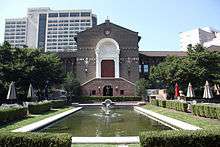
Since the University museum was founded in 1887, it has taken part in 400 research projects worldwide.[71] The museum's first project was an excavation of Nippur, a location in current day Iraq.[72] The museum has three gallery floors with artifacts from Egypt, the Middle East, Mesoamerica, Asia, the Mediterranean, Africa and indigenous artifacts of the Americas.[71] Its most famous object is the goat rearing into the branches of a rosette-leafed plant, from the royal tombs of Ur. The Museum's excavations and collections foster a strong research base for graduate students in the Graduate Group in the Art and Archaeology of the Mediterranean World. Features of the Beaux-Arts building include a rotunda and gardens that include Egyptian papyrus. The Institute of Contemporary Art, which is based on Penn's campus, showcases various art exhibitions throughout the year.
Residences
Every College House at the University of Pennsylvania has at least four members of faculty in the roles of House Dean, Faculty Master, and College House Fellows.[73] Within the College Houses, Penn has nearly 40 themed residential programs for students with shared interests such as world cinema or science and technology. Many of the nearby homes and apartments in the area surrounding the campus are often rented by undergraduate students moving off campus after their first year, as well as by graduate and professional students.
The College Houses include W.E.B. Du Bois, Fisher Hassenfeld, Gregory, Harnwell, Harrison, Hill, Kings Court English, Lauder College House, Riepe, Rodin, Stouffer, and Ware. The first College House was Van Pelt College House, established in the Fall of 1971. It was later renamed Gregory House.[74] Fisher Hassenfeld, Ware and Riepe together make up one building called "The Quad". A new College House called New College House West is planned to open in the next few years.[75]
Campus police
The University of Pennsylvania Police Department (UPPD) is the largest private police department in Pennsylvania, with 117 members. All officers are sworn municipal police officers and retain general law enforcement authority while on the campus.[76]
Academics
| University of Pennsylvania graduate and professional schools[77] | |
|---|---|
| School | Year founded |
| Perelman School of Medicine | 1765[78] |
| School of Engineering and Applied Science | 1850[79] |
| Law School | 1850[note 3] |
| School of Design | 1868 |
| School of Dental Medicine | 1878[81] |
| The Wharton School | 1881[82] |
| Graduate School of Arts and Sciences | 1881[83] |
| School of Veterinary Medicine | 1884[84] |
| Graduate School of Education | 1915 |
| School of Nursing | 1935 |
| Annenberg School for Communication | 1958 |
The College of Arts and Sciences is the undergraduate division of the School of Arts and Sciences. The School of Arts and Sciences also contains the Graduate Division and the College of Liberal and Professional Studies, which is home to the Fels Institute of Government, the master's programs in Organizational Dynamics, and the Environmental Studies (MES) program. Wharton is the business school of the University of Pennsylvania. Other schools with undergraduate programs include the School of Nursing and the School of Engineering and Applied Science (SEAS).
Penn has a strong focus on interdisciplinary learning and research. It offers double degree programs, unique majors, and academic flexibility. Penn's "One University" policy allows undergraduates access to courses at all of Penn's undergraduate and graduate schools except the medical, veterinary and dental schools. Undergraduates at Penn may also take courses at Bryn Mawr, Haverford, and Swarthmore under a reciprocal agreement known as the Quaker Consortium.
Coordinated dual-degree and interdisciplinary programs
Penn offers specialized coordinated dual-degree (CDD) programs, which award candidates degrees from multiple schools at the university upon completion of graduation criteria of both schools. Undergraduate programs include:
- The Jerome Fisher Program in Management and Technology
- Artificial Intelligence: Computer and Cognitive Science
- The Huntsman Program in International Studies and Business
- Nursing and Health Care Management
- The Roy and Diana Vagelos Program in Life Sciences and Management
- Vagelos Scholars Program in Molecular Life Sciences
- Vagelos Integrated Program in Energy Research (VIPER)
- Accelerated 7-year Bio-Dental Program
- Singh Program in Networked & Social Systems Engineering (NETS)[85]
- Accelerated 6-year Law and Medicine Program[86]
- Digital Media Design (DMD)[87]
Dual-degree programs that lead to the same multiple degrees without participation in the specific above programs are also available. Unlike CDD programs, "dual degree" students fulfill requirements of both programs independently without the involvement of another program. Specialized dual-degree programs include Liberal Studies and Technology as well as an Artificial Intelligence: Computer and Cognitive Science Program. Both programs award a degree from the College of Arts and Sciences and a degree from the School of Engineering and Applied Sciences. Also, the Vagelos Scholars Program in Molecular Life Sciences allows its students to either double major in the sciences or submatriculate and earn both a B.A. and an M.S. in four years. The most recent Vagelos Integrated Program in Energy Research (VIPER) was first offered for the class of 2016. A joint program of Penn's School of Arts and Sciences and the School of Engineering and Applied Science, VIPER leads to dual Bachelor of Arts and Bachelor of Science in Engineering degrees by combining majors from each school.
For graduate programs, Penn offers many formalized double degree graduate degrees such as a joint J.D./MBA and maintains a list of interdisciplinary institutions, such as the Institute for Medicine and Engineering, the Joseph H. Lauder Institute for Management and International Studies, and the Institute for Research in Cognitive Science. University of Pennsylvania School of Social Policy and Practice, commonly known as Penn SP2, is a school of social policy and social work that offers degrees in a variety of subfields of social policy and social work, in addition to several dual degree programs and sub-matriculation programs.[88][89][90] Penn SP2's vision is: "The passionate pursuit of social innovation, impact and justice."[91]
Originally named the School of Social Work, SP2 was founded in 1908 and is a graduate school of the University of Pennsylvania. The school specializes in research, education, and policy development in relation to both social and economic issues.[92][93]
Academic medical center and biomedical research complex

In 2018, the University's Nursing school was ranked number one by Quacquarelli Symonds.[94] That year, Quacquarelli Symonds also ranked Penn's school of Veterinary Medicine sixth.[95]
In 2019, the Perelman School of Medicine was named the third-best medical school for research in U.S. News & World Report's 2020 ranking.[96]
However, the size of Penn's biomedical research organization adds a very capital intensive component to the university's operations and introduces revenue instability due to changing government regulations, reduced federal funding for research, and Medicare and Medicaid program changes. This is a primary reason highlighted in bond rating agencies' views on Penn's overall financial rating, which ranks one notch below its academic peers. Penn has worked to address these issues by pooling its schools (as well as several hospitals and clinical practices) into the University of Pennsylvania Health System, thereby pooling resources for greater efficiencies and research impact.
Admissions selectivity
The Princeton Review ranks Penn as the 6th-most selective school in the United States.[97] For the Class of 2024, entering in the fall of 2020,[98] the University received 42,205 applications and admitted 8.07 percent of the applicants.[99] The Atlantic also ranked Penn among the 10 most selective schools in the country. At the graduate level, based on admission statistics from U.S. News & World Report, Penn's most selective programs include its law school, the health care schools (medicine, dental medicine, nursing, veterinary), and Wharton business school.
Research, innovations and discoveries

Penn is classified as an "R1" doctoral university: "Highest research activity."[100] Its economic impact on the Commonwealth of Pennsylvania for 2015 amounted to $14.3 billion.[101] Penn's research expenditures in the 2018 fiscal year were $1.442 billion, the fourth largest in the U.S.[102] In fiscal year 2019 Penn received $582.3 million in funding from the National Institutes of Health.[103] In line with its well-known interdisciplinary tradition, Penn's research centers often span two or more disciplines. In the 2010–2011 academic year alone, five interdisciplinary research centers were created or substantially expanded; these include the Center for Health-care Financing,[104] the Center for Global Women's Health at the Nursing School,[105] the $13 million Morris Arboretum's Horticulture Center,[106] the $15 million Jay H. Baker Retailing Center at Wharton[107] and the $13 million Translational Research Center at Penn Medicine.[108] With these additions, Penn now counts 165 research centers hosting a research community of over 4,300 faculty and over 1,100 postdoctoral fellows, 5,500 academic support staff and graduate student trainees.[7] To further assist the advancement of interdisciplinary research President Amy Gutmann established the "Penn Integrates Knowledge" title awarded to selected Penn professors "whose research and teaching exemplify the integration of knowledge".[109] These professors hold endowed professorships and joint appointments between Penn's schools.
Penn is also among the most prolific producers of doctoral students. With 487 PhDs awarded in 2009, Penn ranks third in the Ivy League, only behind Columbia and Cornell (Harvard did not report data).[110] It also has one of the highest numbers of post-doctoral appointees (933 in number for 2004–2007), ranking third in the Ivy League (behind Harvard and Yale) and tenth nationally.[111] In most disciplines Penn professors' productivity is among the highest in the nation and first in the fields of Epidemiology, Business, Communication Studies, Comparative Literature, Languages, Information Science, Criminal Justice and Criminology, Social Sciences and Sociology.[112] According to the National Research Council nearly three-quarters of Penn's 41 assessed programs were placed in ranges including the top 10 rankings in their fields, with more than half of these in ranges including the top five rankings in these fields.[113]

Penn's research tradition has historically been complemented by innovations that shaped higher education. In addition to establishing the first medical school, the first university teaching hospital, the first business school, and the first student union, Penn was also the cradle of other significant developments. In 1852, Penn Law was the first law school in the nation to publish a law journal still in existence (then called The American Law Register, now the Penn Law Review, one of the most cited law journals in the world).[114] Under the deanship of William Draper Lewis, the law school was also one of the first schools to emphasize legal teaching by full-time professors instead of practitioners, a system that is still followed today.[115] The Wharton School was home to several pioneering developments in business education. It established the first research center in a business school in 1921 and the first center for entrepreneurship center in 1973[116] and it regularly introduced novel curricula for which BusinessWeek wrote, "Wharton is on the crest of a wave of reinvention and change in management education".[117][118]
Several major scientific discoveries have also taken place at Penn. The university is probably best known as the place where the first general-purpose electronic computer (ENIAC) was born in 1946 at the Moore School of Electrical Engineering.[119] It was here also where the world's first spelling and grammar checkers were created, as well as the popular COBOL programming language.[119] Penn can also boast some of the most important discoveries in the field of medicine. The dialysis machine used as an artificial replacement for lost kidney function was conceived and devised out of a pressure cooker by William Inouye while he was still a student at Penn Med;[120] the Rubella and Hepatitis B vaccines were developed at Penn;[120] the discovery of cancer's link with genes, cognitive therapy, Retin-A (the cream used to treat acne), Resistin, the Philadelphia gene (linked to chronic myelogenous leukemia) and the technology behind PET Scans were all discovered by Penn Med researchers.[120] More recent gene research has led to the discovery of the genes for fragile X syndrome, the most common form of inherited mental retardation; spinal and bulbar muscular atrophy, a disorder marked by progressive muscle wasting; and Charcot–Marie–Tooth disease, a progressive neurodegenerative disease that affects the hands, feet and limbs.[120] Conductive polymer was also developed at Penn by Alan J. Heeger, Alan MacDiarmid and Hideki Shirakawa, an invention that earned them the Nobel Prize in Chemistry. On faculty since 1965, Ralph L. Brinster developed the scientific basis for in vitro fertilization and the transgenic mouse at Penn. The theory of superconductivity was also partly developed at Penn, by then-faculty member John Robert Schrieffer (along with John Bardeen and Leon Cooper). The university has also contributed major advancements in the fields of economics and management. Among the many discoveries are conjoint analysis, widely used as a predictive tool especially in market research, Simon Kuznets's method of measuring Gross National Product,[121] the Penn effect (the observation that consumer price levels in richer countries are systematically higher than in poorer ones) and the "Wharton Model"[122] developed by Nobel-laureate Lawrence Klein to measure and forecast economic activity. The idea behind Health Maintenance Organizations also belonged to Penn professor Robert Eilers, who put it into practice during then-President Nixon's health reform in the 1970s.[121]
Academic Profile
International partnerships
Students can study abroad for a semester or a year at partner institutions such as Sciences Po, University of Queensland, University College London, King's College London, London School of Economics, and University of Warwick.
General rankings
U.S. News & World Report's 2020 rankings place Penn 6th among national universities in the United States.[123] The Princeton Review includes Penn in its Dream Colleges list.[124] As reported by USA Today, Penn was ranked 1st in the United States by College Factual for 2015.[125]
In their 2020 edition, Penn was ranked 15th in the world by the QS World University Rankings[126] and in 2019, 17th by the Academic Ranking of World Universities (ARWU) and 12th by the Times Higher Education World University Rankings. In 2019, it ranked 12th among the universities around the world by SCImago Institutions Rankings.[127] According to the 2015 ARWU ranking, Penn is also the 8th- and 9th-best university in the world for economics/business and social sciences studies, respectively.[128] University of Pennsylvania ranked 12th among 300 Best World Universities in 2012 compiled by Human Resources & Labor Review (HRLR) on Measurements of World's Top 300 Universities Graduates' Performance.[129]
|
|
| ||||||||||||||||||||||||||||||||||||||||||||||||||||||||||||||||||||||||||||||||||||||||||||||||||||||||||||||||||||||||||||||||||||||||||
Research rankings
The Center for Measuring University Performance places Penn in the first tier of the United States' top research universities (tied with Columbia, MIT and Stanford), based on research expenditures, faculty awards, PhD granted and other academic criteria.[141] Penn was also ranked 18th of all U.S. colleges and universities in terms of R&D expenditures in fiscal year 2013 by the National Science Foundation.[142] The High Impact Universities research performance index ranks Penn 8th in the world, whereas the 2010 Performance Ranking of Scientific Papers for World Universities (published by the Higher Education Evaluation and Accreditation Council of Taiwan) ranks Penn 11th in the world for 2007,[143] 2008 [144] and 2010 [145] and 9th for 2009.[146]
The Performance Ranking of Scientific Papers measures universities' research productivity, research impact, and research excellence based on the scientific papers published by their academic staff. The SCImago Institutions Rankings World Report 2012, which ranks world universities, national institutions and academies in terms of research output, ranks Penn 7th nationally among U.S. universities (2nd in the Ivy League behind Harvard) and 28th in the world overall (the first being France's Centre National de la Recherche Scientifique).[147]
Other rankings
The Mines ParisTech International Professional Ranking, which ranks universities on the basis of the number of alumni listed among CEOs in the 500 largest worldwide companies, ranks Penn 11th worldwide and 2nd nationally behind Harvard.[148] According to a U.S. News article in 2010, Penn is tied for second (tied with Dartmouth College and Tufts University) for the number of undergraduate alumni who are current Fortune 100 CEOs.[149] Forbes ranked Penn 17th, based on a variety of criteria.[150]
Graduate and professional programs
Among its professional schools, the schools of education, business, communication, dentistry, medicine, nursing, and veterinary medicine rank in the top 5 nationally.[151] Penn's Law School,Design school, and its School of Social Policy and Practice are ranked in the top 10 [151] In the 2010 QS Global 200 Business Schools Report, Penn was ranked 2nd in North America.[152]
Executive salary
Amy Gutmann's total compensation in 2018 was $3.9 million, placing her as the third-highest paid college president in the nation and second in the Ivy League.[153]
Student life
| Ethnic enrollment, Fall 2018[154] |
Under- graduates |
|---|---|
| African American | 715 (7.1%) |
| Native American | 12 (0.1%) |
| Asian American and Pacific Islander |
2,084 (20.7%) |
| Hispanic and Latino American |
1,044 (10.4%) |
| White | 4,278 (42.6%) |
| International | 1,261 (12.6%) |
| Two or more races, non-Hispanic | 460 (4.6%) |
| Unknown | 179 (1.8%) |
| Total | 10,033 (100%) |


Demographics
Of those accepted for admission to the undergraduate Class of 2018, 52 percent are Asian, Hispanic, African-American or Native American.[7] In addition, 53% of current students are women.[7]
Twelve percent of the undergraduate Class of 2018 were international students.[7] The composition of international students accepted in the Class of 2018 is: 43% from Asia; 15% from Africa and the Middle East; 20% from Europe; 15% from Canada and Mexico; 5% from the Caribbean, Central America and South America; 3% from Australia and the Pacific Islands.[7] The acceptance rate for international students applying for the class of 2018 was 429 out of 6,428 (6.7%).[7]
Circa 1999 about 28% of the students were Jewish.[155]
Penn Face and suicides
The university's social pressure surrounding academic perfection, extreme competitiveness, and nonguaranteed readmission have created what is known as "Penn Face": students put on a façade of confidence and happiness while enduring mental turmoil.[156][157][158][159][160] Stanford University calls this phenomenon "Duck Syndrome."[159][161] In recent years, mental health has become an issue on campus with ten student suicides between the years of 2013 to 2016.[162] The school responded by launching a task force.[163][164] The most widely covered case of Penn Face has been Maddison Holleran.[165][166] In 2018, initiatives were enacted to ameliorate mental health problems, such as requiring sophomores to live on campus and the daily closing of Huntsman Hall at 2:00 a.m.[167][168] The university's suicide rate was the catalyst for a 2018 state bill, introduced by Governor Tom Wolf, to raise Pennsylvania's standards for university suicide prevention.[169] The university's efforts to address mental health on campus came into the national spotlight again in September 2019 when the director of the university's counseling services committed suicide nine months after starting the position.[170]
Selected student organizations
The Philomathean Society, founded in 1813, is one of the United States' oldest collegiate literary society and continues to host lectures and intellectual events open to the public.[171] The Mask and Wig Club, founded in 1889, is the oldest all-male musical comedy troupe in the country. The University of Pennsylvania Glee Club, founded in 1862, is one of the oldest continually operating collegiate choruses in the United States. Bruce Montgomery, its best-known and longest-serving director, led the club from 1956 until 2000.[172] The International Affairs Association (IAA) was founded in 1963 as an organization to promote international affairs and diplomacy at Penn and beyond.[173] With over 400 members, it is the largest student-funded organization on campus. The IAA serves as an umbrella organization for various conferences (UPMUNC, ILMUNC, and PIRC), as well as a host of other academic and social activities. The Student Committee on Undergraduate Education (SCUE), founded in 1965, is the education policy branch of the Penn student government, whose sole mission is to improve undergraduate education at Penn.[174] The Penn Debate Society (PDS), founded in 1984 as the Penn Parliamentary Debate Society, is Penn's debate team, which competes regularly on the American Parliamentary Debate Association and the international British Parliamentary circuit.[175] The PDS has a history of success, consistently fielding debaters ranked in the top 10 nationally and advancing teams to elimination rounds at the World University Debating Championships.
The University of Pennsylvania Band has been a part of student life since 1897.[176] The Penn Band performs at football and basketball games as well as university functions (e.g. commencement and convocation) throughout the year and was the first college band to perform at Macy's Thanksgiving Day Parade.[176] Membership fluctuates between 80 and 100 students.[176]
The PennApps organization at the University of Pennsylvania was created in fall 2009 and hosted the United States' first student-run hackathon "PennApps" in 2008. As of fall 2019, they have hosted 20 iterations of this international hackathon.
- Performing arts organizations
Penn is home to numerous organizations that promote the arts, from dance to spoken word, jazz to stand-up comedy, theatre, a cappella and more. The Performing Arts Council (PAC) oversees 45 student organizations in these areas.[177] The PAC has four subcommittees: A Cappella Council; Dance Arts Council; Singer, Musicians, and Comedians (SMAC); and Theatre Arts Council (TAC-e).
The Dance Arts Council (DAC) comprises 13 organizations, including the African Rhythms, Pan-Asian Dance Troupe and the West Philly Swingers.[178] The Arts House Dance Company is one of the council's most prominent groups. Founded in 1985, the Company is known for its strong technique, innovative student choreography and vivid stage presence.[179]
The A Cappella Council (ACK) is composed of 14 a cappella groups. Penn's a cappella groups entertain audiences with repertoires including pop, rock, R&B, jazz, Hindi, and Chinese songs.[180] ACK is also home to Off The Beat, which has received the most Contemporary A Cappella Recording Awards of any collegiate group in the United States and the most features on the Best of College A Cappella albums.[181]
- Religious organizations
Dating back to 1857, The Christian Association (a.k.a. The CA) is the oldest religious organization at the university and is composed primarily of students from Mainline Protestant backgrounds.[182] When the University moved to its current campus in the 1880s the CA was based out of Houston Hall. After moving around several times it relocated to its new building at 36th and Locust Streets (now the ARCH Building), which it occupied from 1928 until 2000. During its most active period, it ran several foreign missions as well as a camp for socio-economically disadvantaged children in Philadelphia.[183] At present the CA occupies part of the parsonage at Tabernacle United Church of Christ.[184]
The Rohr Jewish Learning Institute's Sinai Scholars Society Academic Symposium is a prestigious event that brings together Jewish college students with noted Jewish academics for a day of in-depth discussion and debate at the university.[185][186] The Penn branch of Hillel International or Hillel, the largest Jewish campus organization in the world, working with thousands of college students globally, reaches over 80% of the roughly 1,750 Jewish undergraduate students and the roughly 1,800 Jewish graduate and professional students on campus with an array of different Jewish opportunities in over 25 different groups utilizing space in the 35,000 square foot Steinhardt Hall, ranging from social justice to Israel to Jewish culture offerings to Jewish religious expression (with services catering to all four of the mainstream branches of Judaism including a kosher dining hall).
The Penn Newman Catholic Center (the Newman Center) was founded in 1893 (and was the first Newman Center in the country) with the mission of supporting students, faculty, and staff in their religious endeavors. The organization brings prominent Christian figures to campus, including Father Thomas "Tom" O. Hagan, SFS, founder of not for profit sited in Haiti, www.HandsTogether.org and James Martin in September 2015.[187] During the 2015 World Meetings of Families, which included a visit from Pope Francis to Philadelphia, the Newman Center hosted over 900 Penn students and alumni.[187]
- The Daily Pennsylvanian
The Daily Pennsylvanian is an independent, student-run newspaper, which has been published daily since it was founded in 1885.[188] The newspaper went unpublished from May 1943 to November 1945 due to World War II.[188] In 1984, the university lost all editorial and financial control of The Daily Pennsylvanian when the newspaper became its own corporation.[188] The Daily Pennsylvanian has won the Pacemaker Award administered by the Associated Collegiate Press multiple times, most recently in 2019.[189][190]
Athletics
Penn's sports teams are nicknamed the Quakers, but the teams are often also referred to as The Red & Blue. The athletes participate in the Ivy League and Division I (Division I FCS for football) in the NCAA. In recent decades, they often have been league champions in football (14 times from 1982 to 2010) and basketball (22 times from 1970 to 2006). The first athletic team at Penn was its cricket team.[191]
Rowing
.jpg)
Rowing at Penn dates back to at least 1854 with the founding of the University Barge Club. The university currently hosts both heavyweight and lightweight men's teams and an open weight women's team, all of which compete as part of the Eastern Sprints League. Penn Rowing has produced a long list of famous coaches and Olympians, including Susan Francia, John B. Kelly Jr., Joe Burk, Rusty Callow, Harry Parker and Ted Nash. Also, the 1955 men's heavyweight crew is one of only four American university crews to win the Grand Challenge Cup at the Henley Royal Regatta. The teams row out of College Boat Club, No.11 Boathouse Row.
Rugby
The Penn Men's Rugby Football team is one of the oldest collegiate rugby teams in America. Indeed, Penn first fielded a team in mid 1870s playing by rules much closer to the rugby union and Association Football code rules (than American Football rules as such American Football rules had not yet been invented). (See https://www.ussoccerhistory.org/the-origins-of-soccer-in-philadelphia-part-5-local-college-based-football-after-the-1863-laws-of-the-game/) Among its earliest games was a game against College of New Jersey (which in 1895 changed its name to Princeton) played in Philadelphia on Saturday, November 11, 1876, which was less than two weeks before Princeton met on November 23, 1876 with Harvard and Columbia to confirm that all their games would be played using the rugby union rules.[192] Princeton and Penn played their November 1876 game per a combination of rugby (there were 20 players per side and players were able to touch the ball with their hands) and Association Football codes. The rugby code influence was due, in part, to fact that some of their students had been educated in English public schools.[193] and by 1869 Princeton was playing with rules substantially identical to rugby.[193] Among the prominent alumni to play in a 19th century version of rugby (rules that did not allow forward passes or center snaps) was John Heisman, namesake of the Heisman Trophy and a 1892 graduate of the University of Pennsylvania Law School. Heisman was instrumental in the first decade of the 20th century in changing the rules to more closely relate to present rules of American football.[194]
From 1906 to 1912 Penn played per rugby union code rules even after Penn started playing American Football. Evidence of such may be found in an October 22, 1910 Daily Pennsylvanian article (quoted below) and a yearbook photo (see https://www.ivyrugby.com/penn-men) that rugby per rugby union code was played. “Such is the devotion to English rugby football on the part of University of Pennsylvania's students from New Zealand, Australia, and England that they meet on Franklin Field at 7 o'clock every morning and practice the game. The varsity track and football squads monopolize the field to such an extent that the early hours of the morning are the only ones during which the rugby enthusiasts can play. Any time except Friday, Saturday and Sunday, a squad of 25 men may be seen running through the hardest kind of practice after which they may divide into two teams and play a hard game. Once a week, captain CC Walton, ('11), dental, who hails from New Zealand, gives the enthusiastic players a blackboard talk in which he explains the intricacies of the game in detail.” October 22, 1910 The Daily Pennsylvanian
The player coach of United States Olympic gold winning rugby team at 1924 Summer Olympics was Alan Valentine, who played rugby while at Penn as he was getting a Master's degree at Wharton.
In the early 1960s, Penn Men's rugby became permanent due to leadership of Harry "Joe" Edwin Reagan III, Penn's College Class of 1962 and Penn Law Class of 1965, who also went onto help create and incorporate in 1975 USA Rugby. Thus, with Reagan's charisma and organizational skills, a team, which had fielded a team intermittently from 1910 through 1960, became permanent.
In the early 1980s, Penn Women's rugby led by women such as Penn Law alumna, Gigi Sohn began to compete. Penn Women's rugby team is coached, as of 2020, by (a) Adam Dick, a 300-level certified coach with over 15 years of rugby coaching experience including being the first coach of the first women's rugby team at the University of Arizona and who was a four year starter at University of Arizona Men's first XV rugby team and (b) Philly Women's player Kate Hallinan.
Penn's Men's rugby team plays in the Ivy Rugby Conference and have finished as runners-up in both 15s and 7s.[195] As of 2011, the club uses the state-of-the-art facilities at Penn Park. Quakers Rugby played on national TV at the 2013 Collegiate Rugby Championship, a college rugby tournament played every June at PPL Park in Philadelphia and broadcast live on NBC. In their inaugural year of participation, the Penn men's rugby team won the Shield Competition, beating local rivals Temple University 17–12 in the final. In doing so, they became the first Philadelphia team to beat a non-Philadelphia team in CRC history, with a 14–12 win over the University of Texas in the Shield semifinal.[196]
Penn Men's Rugby, as of 2020, is coached by (a) Tiger Bax, a former professional rugby player hailing from Cape Town, South Africa, whose vast (1) playing experience includes stints in the Super Rugby competition with the Stormers (15s) and Mighty Mohicans (7s), as well as with the Gallagher Premiership Rugby side, Saracens, and (2) coaching experience includes three successful years as coach at Valley Rugby Football Club in Hong Kong and (b) Tyler May, from Cherry Hill, New Jersey, who played rugby at Pennsylvania State University where he was a first XV player for three years.
The 2019 Men's team has the most geographically diverse team of any PennRec team as its players come from eleven different countries (as defined by International Olympic Committee: Australia, Botswana, Chile, Great Britain, Malaysia, Netherlands, New Zealand, People's Republic of China (Capital - Beijing), Republic of China (Capital - Taipei), South Africa, and United States).
Penn's graduate and professional schools also fielded rugby teams with (a) Penn Law Rugby team (1985 through 1993) counting among its scores of alumni, Walter Joseph "Jay" Clayton III (Jay Clayton, Penn Law Class of 1993) present Chair of U.S. Securities and Exchange Commission and Raymond N. Hulser, Penn Law Class of 1987, Chief of The Public Integrity Section of the Criminal Division of the U.S. Department of Justice.[197] , and (b) Wharton Rugby Team (1978 through to present) counting hundreds of alumni (nicknamed "hogs" short for "Wharthogs"). See http://www.wharthogs.com/ (accessed June 12, 2020)
Cricket
In the latter half of the nineteenth century and the early twentieth Philadelphia was the center of cricket in the United States. Cricket had gained in popularity among the upper class from their travels abroad and cricket clubs sprung up all across the Eastern Seaboard (even today Philadelphia still has three cricket clubs—the Philadelphia, the Merion and the Germantown). Many East Coast universities and colleges fielded cricket teams with the University of Pennsylvania and Haverford College being two of the best in the country. (Cricket was the first organized sport at Pennsylvania.) The Penn Cricket Team frequently toured Canada and the British Isles and even defeated a combined Oxford-Cambridge team in 1895.[198] Perhaps the University's most famous cricket player was George Patterson who went on to play for the professional Philadelphia Cricket Team. Following the First World War, cricket began to experience a serious decline as baseball became the preferred sport of the warmer months, but to this day the University still fields a cricket team.
Football

Penn first fielded a football team against Princeton at the Germantown Cricket Club in Philadelphia on November 11, 1876.[192]
Penn football made many contributions to the sport in its early days. During the 1890s, Penn's famed coach and alumnus George Washington Woodruff introduced the quarterback kick, a forerunner of the forward pass, as well as the place-kick from scrimmage and the delayed pass. In 1894, 1895, 1897 and 1904, Penn was generally regarded as the national champion of collegiate football.[192] The achievements of two of Penn's outstanding players from that era, John Heisman, a University of Pennsylvania Law School alumnus, and John Outland, a Penn Med alumnus, are remembered each year with the presentation of the Heisman Trophy to the most outstanding college football player of the year, and the Outland Trophy to the most outstanding college football interior lineman of the year.
Also, each year the Bednarik Award is given to college football's best defensive player. Chuck Bednarik (Class of 1949) was a three-time All-American center/linebacker who starred on the 1947 team and is generally regarded as Penn's all-time finest. In addition to Bednarik, the 1947 squad boasted four-time All-American tackle George Savitsky and three-time All-American halfback Skip Minisi. All three standouts were subsequently elected to the College Football Hall of Fame, as was their coach, George Munger (a star running back at Penn in the early 1930s). Bednarik went on to play for 12 years with the Philadelphia Eagles, becoming the NFL's last 60-minute man. He was elected to the Pro Football Hall of Fame in 1969. During his presidency of the institution from 1948 to 1953, Harold Stassen attempted to recultivate Penn's heyday of big-time college football, but the effort lacked support and was short-lived.
ESPN's College GameDay traveled to Penn to highlight the Harvard-Penn game on November 17, 2002, the first time the popular college football show had visited an Ivy League campus.
Basketball
Penn basketball is steeped in tradition. Penn made its only (and the Ivy League's second) Final Four appearance in 1979, where the Quakers lost to Magic Johnson-led Michigan State in Salt Lake City. (Dartmouth twice finished second in the tournament in the 1940s, but that was before the beginning of formal League play.) Penn's team is also a member of the Philadelphia Big 5, along with La Salle, Saint Joseph's, Temple and Villanova. In 2007, the men's team won its third consecutive Ivy League title and then lost in the first round of the NCAA Tournament to Texas A&M.
Facilities
Franklin Field is where the Quakers play football, field hockey, lacrosse, sprint football and track and field (and formerly soccer and rugby). It is the oldest stadium still operating for football games and was the first stadium to sport two tiers. It hosted the first commercially televised football game, was once the home field of the Philadelphia Eagles, and was the site of 18 Army–Navy games between 1899 and 1935.[199]
Today it is also used by Penn students for recreation such as intramural and club sports, including touch football and cricket. Franklin Field hosts the annual collegiate track and field event "the Penn Relays."
Penn's home court, the Palestra, is an arena used for men's and women's basketball teams, volleyball teams, wrestling team and Philadelphia Big Five basketball, as well as high school sporting events. The Palestra has hosted more NCAA Tournament basketball games than any other facility. Penn baseball plays its home games at Meiklejohn Stadium.
The Olympic Boycott Games of 1980 was held at the University of Pennsylvania in response to Moscow's hosting of the 1980 Summer Olympics following the Soviet incursion in Afghanistan. Twenty-nine of the boycotting nations participated in the Boycott Games.
Notable people
 Francis Hopkinson, signed the Declaration of Independence and designed the first official American Flag
Francis Hopkinson, signed the Declaration of Independence and designed the first official American Flag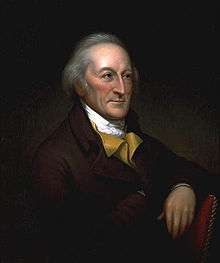
 James Wilson, Founding father; one of the six original justices appointed by George Washington to the Supreme Court of the United States
James Wilson, Founding father; one of the six original justices appointed by George Washington to the Supreme Court of the United States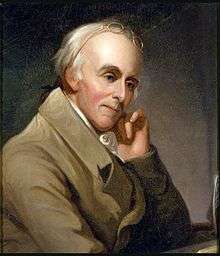
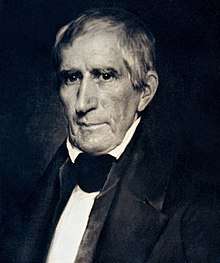 William Henry Harrison, 9th President of the United States
William Henry Harrison, 9th President of the United States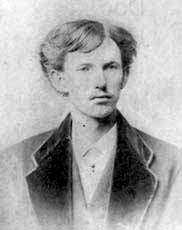 Doc Holliday, famed gunslinger, attended the Pennsylvania College of Dental Surgery
Doc Holliday, famed gunslinger, attended the Pennsylvania College of Dental Surgery Martha Hughes Cannon, first female State Senator elected in the United States
Martha Hughes Cannon, first female State Senator elected in the United States William Wrigley, Jr., founder and eponym of the Wm. Wrigley Jr. Company
William Wrigley, Jr., founder and eponym of the Wm. Wrigley Jr. Company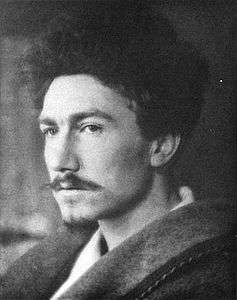 American poet and critic Ezra Pound, a major figure in the early modernist movement, studied at the College[200]
American poet and critic Ezra Pound, a major figure in the early modernist movement, studied at the College[200]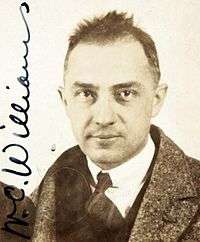 Physician and poet William Carlos Williams graduated from Penn's School of Medicine
Physician and poet William Carlos Williams graduated from Penn's School of Medicine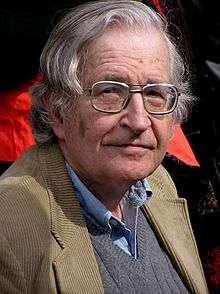 Noam Chomsky studied philosophy and linguistics at Penn, graduating with a BA in 1949, an MA in 1951 and a Ph.D. in 1955
Noam Chomsky studied philosophy and linguistics at Penn, graduating with a BA in 1949, an MA in 1951 and a Ph.D. in 1955 Donald Trump, American businessman, reality television personality and 45th President of the United States
Donald Trump, American businessman, reality television personality and 45th President of the United States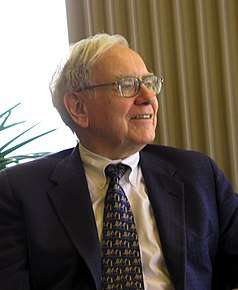 Warren Buffett, considered by some to be one of the most successful investors in the world[201][202]
Warren Buffett, considered by some to be one of the most successful investors in the world[201][202] Arlen Specter, former U.S. Senator majored in international relations and graduated Phi Beta Kappa in 1951
Arlen Specter, former U.S. Senator majored in international relations and graduated Phi Beta Kappa in 1951.jpg)
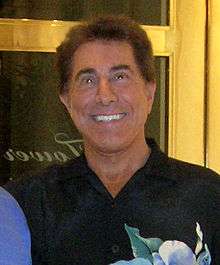 Steve Wynn, known for his involvement in the luxury casino and hotel industry
Steve Wynn, known for his involvement in the luxury casino and hotel industry- Ed Rendell, 45th Governor of Pennsylvania; 96th Mayor of Philadelphia
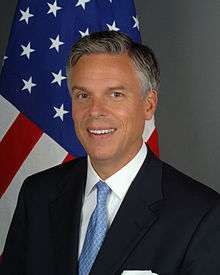 Jon Huntsman Jr., politician, businessman, and diplomat
Jon Huntsman Jr., politician, businessman, and diplomat
Penn has produced many alumni that have distinguished themselves in the sciences, academia, politics, the military, arts and media.[206]
Fourteen heads of state or government have attended or graduated from Penn, including current president Donald J. Trump, former president William Henry Harrison, who attended the medical school for less than a semester;[207] former Prime Minister of the Philippines Cesar Virata; the first president of Nigeria, Nnamdi Azikiwe; the first president of Ghana, Kwame Nkrumah; and the current president of Ivory Coast, Alassane Ouattara. Other notable politicians who hold a degree from Penn include India's Minister of State for Finance Jayant Sinha,[208] former ambassador to Russia, former ambassador to China, former 2012 presidential candidate, and former Utah governor Jon Huntsman, Jr., Mexico's current minister of finance, Ernesto J. Cordero, former Pennsylvania senator Arlen Specter, and former Pennsylvania governor and DNC Chair Ed Rendell.
The university's presence in the judiciary in and outside of the United States is also notable. It has produced three United States Supreme Court justices, William J. Brennan, Owen J. Roberts and James Wilson, Supreme Court justices of foreign states (e.g., Ronald Wilson of the High Court of Australia, Ayala Procaccia of the Israel Supreme Court and Yvonne Mokgoro, former Justice of the Constitutional Court of South Africa, its Supreme Constitutional Court), European Court of Human Rights judge Nona Tsotsoria, Irish Court of Appeal justice Gerard Hogan and founders of international law firms, e.g. James Harry Covington (co-founder of Covington & Burling), Martin Lipton (co-founder of Wachtell, Lipton, Rosen, & Katz) and George Wharton Pepper (U.S. Senator from Pennsylvania and founder of Pepper Hamilton).
Penn alumni also have a strong presence in financial and economic life. Penn has educated several governors of central banks including Yasin Anwar (State Bank of Pakistan), Ignazio Visco (Bank of Italy), Kim Choongsoo (Bank of Korea), Zeti Akhtar Aziz (Central Bank of Malaysia), Pridiyathorn Devakula (Governor, Bank of Thailand, and former Minister of Finance), Farouk El Okdah (Central Bank of Egypt) and Alfonso Prat Gay (Central Bank of Argentina), as well as the director of the United States National Economic Council, Gene Sperling. Founders of technology companies include Ralph J. Roberts (co-founder of Comcast), Elon Musk (co-founder of PayPal, founder and CEO of Tesla Motors and SpaceX), Leonard Bosack (co-founder of Cisco), David J. Brown (co-founder of Silicon Graphics) and Mark Pincus (founder of Zynga, the company behind FarmVille). Other notable businessmen and entrepreneurs who attended or graduated from the University of Pennsylvania include William S. Paley (former president of CBS), Warren Buffett [note 4] (CEO of Berkshire Hathaway), Donald Trump, Jr., and Ivanka Trump, Safra Catz (president and CFO of Oracle Corporation), Leonard Lauder (chairman emeritus of Estée Lauder Companies and son of founder Estée Lauder), Steven A. Cohen (founder of SAC Capital Advisors), Robert Kapito (president of BlackRock, the world's largest asset manager), Sundar Pichai (CEO of Alphabet Inc.), P. Roy Vagelos (former president and CEO of multinational pharmaceutical company Merck & Co.) and Baidyanath Misra, former Vice-Chancellor of the Odisha University of Agriculture and Technology.
Among other distinguished alumni are the current or past presidents of over one hundred Universities including Harvard University, Drew Gilpin Faust, Harvard's first female President; Cornell University, Martha E. Pollack; Penn, Judith Rodin, first female President in Ivy League; Princeton University, Harold Dodds; the University of California, Mark Yudof; Carnegie Mellon University, Jared Cohon; and Northwestern University, Morton O. Schapiro.
Penn's alumni also include poets William Augustus Muhlenberg, Ezra Pound and William Carlos Williams, linguist and political theorist Noam Chomsky, architect Louis Kahn, cartoonist Charles Addams, actresses Candice Bergen and Elizabeth Banks, theatrical producer Harold Prince, motion picture producer Robert W. Cort, counter-terrorism expert and author Richard A. Clarke, pollster and strategist Frank Luntz, attorney Gloria Allred, journalist Joe Klein, fashion designer Tory Burch, recording artist John Legend, football athlete and coach John Heisman, former U.S. Deputy Attorney General Rod Rosenstein, philosopher Hilary Putnam, and SEC Chairman Jay Clayton.
Within the ranks of Penn's most historic graduates are also eight signers of the Declaration of Independence and nine signers of the Constitution. These include George Clymer, Francis Hopkinson, Thomas McKean, Robert Morris, William Paca, George Ross, Benjamin Rush, James Wilson, Thomas Fitzsimons, Jared Ingersoll, Rufus King, Thomas Mifflin, Gouverneur Morris and Hugh Williamson.
As of October 2019, 36 Penn affiliates have won Nobel Prizes, of whom four are current faculty members and eight are alumni. Penn also counts 115 members of the United States National Academies, 79 members of the Academy of Arts and Sciences, eight National Medal of Science laureates, 108 Sloan Fellows, 30 members of the American Philosophical Society and 170 Guggenheim Fellowships.
See also
- List of universities by number of billionaire alumni
- Education in Philadelphia
- Think Tanks and Civil Societies Program (TTCSP)
- University of Pennsylvania Press
Notes
- The University officially uses 1740 as its founding date and has since 1899. The ideas and intellectual inspiration for the academic institution stem from 1749, with a pamphlet published by Benjamin Franklin (1705/1706–1790). When Franklin's institution was established, it inhabited a schoolhouse built on November 14, 1740 for another school, which never came to practical fruition.[1] Penn archivist Mark Frazier Lloyd noted, "In 1899, UPenn's Trustees adopted a resolution that established 1740 as the founding date, but good cases may be made for 1749, when Franklin first convened the Trustees, or 1751, when the first classes were taught at the affiliated secondary school for boys, Academy of Philadelphia, or 1755, when Penn obtained its collegiate charter to add a post-secondary institution, the College of Philadelphia."[2] Princeton's library presents another diplomatically-phrased view.[3]
- Penn is the fourth-oldest using the founding dates claimed by each institution. The College of Philadelphia (later Penn), College of New Jersey (later Princeton University) and King's College (later Columbia College, now Columbia University) all originated within a few years of each other. After initially designating 1750 as its founding date, Penn later considered 1749 to be its founding date for more than a century, including alumni observing a centennial celebration in 1849. In 1895, several elite universities in the United States convened in New York City as the "Intercollegiate Commission" at the invitation of John J. McCook, a Union Army officer during the American Civil War and member of Princeton's board of trustees who chaired its Committee on Academic Dress. The primary purpose of the conference was to standardize American academic regalia, which was accomplished through the adoption of the Intercollegiate Code on Academic Costume. This formalized protocol included a provision that henceforth academic processions would place visiting dignitaries and other officials in the order of their institution's founding dates. The following year, Penn's The Alumni Register magazine, published by the General Alumni Society, began a campaign to retroactively revise the University's founding date to 1740, to become older than Princeton, which had been chartered in 1746. Three years later in 1899, Penn's board of trustees acceded to this alumni initiative and officially changed its founding date from 1749 to 1740, affecting its rank in academic processions as well as the informal bragging rights that come with the age-based hierarchy in academia generally. See "Building Penn's Brand" for more details on why Penn did this.[25] Princeton implicitly challenges this rationale,[26] also considering itself to be the nation's fourth-oldest institution of higher learning.[27] To further complicate the comparison, a University of Edinburgh-educated Presbyterian minister from Scotland, named William Tennent and his son Gilbert Tennent operated a "Log College" in Bucks County, Pennsylvania, from 1726 until 1746; some have suggested a connection between it and Princeton because five members of Princeton's first Board of Trustees were affiliated with the "Log College", including Gilbert Tennent, William Tennent, Jr., and Samuel Finley, the latter of whom later became President of Princeton. All twelve members of Princeton's first Board of Trustees were leaders from the "New Side" or "New Light" wing of the Presbyterian Church in the New Jersey, New York and Pennsylvania areas.[28] This antecedent relationship, when considered a formal lineage with institutional continuity, would justify pushing Princeton's founding date back to 1726, earlier than Penn's 1740. However, Princeton has not done so, and a Princeton historian says that "the facts do not warrant" such an interpretation.[29] Columbia also implicitly challenges Penn's use of either 1750, 1749 or 1740, as it claims to be the fifth oldest institution of higher learning in the United States (after Harvard, William & Mary, Yale and Princeton), based upon its charter date of 1754 and Penn's charter date of 1755.[30] Academic histories of American higher education generally list Penn as fifth or sixth, after Princeton and immediately before or after that of Columbia.[31][32][33] Even Penn's account of its early history agrees that the original secondary school (the Academy of Philadelphia) did not add an institution of higher learning (the College of Philadelphia) until 1755, but university officials continue to make it their practice to assert their fourth-oldest place in academic processions. Other American universities that began as a colonial-era, early version of secondary schools such as St. John's College (founded as "King William's School" in 1696) and the University of Delaware (founded as "the Free Academy" in 1743) choose to march based upon the date they became institutions of higher learning. Penn History Professor Edgar Potts Cheyney was a member of the Penn class of 1883 who played a leading role in the 1896-1899 alumni campaign to change the university's formal founding date. According to Cheyney's later history of the event, the university did indeed consider its founding date to be 1749 for almost a century. However, it was changed with good reason, and primarily due to a publication about the university issued by the U.S. Commissioner of Education written by Francis Newton Thorpe, a fellow alumnus, and colleague in the Penn history department. The year 1740 is the date of the establishment of the first educational trust that the University had taken upon itself. Cheyney states further that "it might be considered a lawyer's date; it is a familiar legal practice in considering the date of any institution to seek out the oldest trust it administers". He also points out that Harvard's founding date is also the year in which the Massachusetts General Court (state legislature) resolved to establish a fund in a year's time for a "School or College". As well, Princeton claims its founding date as 1746, the date of its first charter. However, the exact words of the charter are unknown, the number and names of the trustees in the charter are unknown, and no known original is extant. Except for Columbia University, the majority of the American Colonial Colleges do not have clear-cut dates of foundation [34]
- In 1790, the first lecture on law was given by James Wilson; however, a full time program was not offered until 1850.[80]
- Buffett studied at Penn for two years before he transferred to the University of Nebraska.
References
- "Penn History Exhibits - University Archives and Records Center". archives.upenn.edu. Archived from the original on August 22, 2019. Retrieved January 31, 2019.
- "A Penn Trivial Pursuit - Penn Current". web.archive.org. June 3, 2011. Archived from the original on June 3, 2011.
- "Seeley G. Mudd Library : FAQ Princeton vs. University of Pennsylvania: Which is the Older Institution?". web.archive.org. March 19, 2003. Archived from the original on March 19, 2003.
- As of June 30, 2019. "U.S. and Canadian 2019 NTSE Participating Institutions Listed by Fiscal Year 2019 Endowment Market Value, and Percentage Change in Market Value from FY18 to FY19 (Revised)". National Association of College and University Business Officers and TIAA. Retrieved April 24, 2020.
- "Operating Budget". Office of Budget and Management Analysis. University of Pennsylvania. Archived from the original on November 12, 2019. Retrieved January 19, 2020.
- "The Trustees". Office of the University Secretary, Penn. January 1, 2018. Archived from the original on October 4, 2017. Retrieved March 15, 2018.
- "Penn: Penn Facts". University of Pennsylvania. Archived from the original on October 23, 2019. Retrieved January 18, 2020.
- "Common Data Set 2019-20" (PDF). University of Pennsylvania. Retrieved March 23, 2020.
- "Logo & Branding Standards". University of Pennsylvania. Archived from the original on July 23, 2019. Retrieved April 1, 2016.
- "Penn's Heritage". University of Pennsylvania. Archived from the original on April 22, 2016. Retrieved May 8, 2016.
- Tannenbaum, Seth S. "Undergraduate Student Governance at Penn, 1895–2006". University Archives and Research Center. University of Pennsylvania. Archived from the original on April 23, 2017. Retrieved August 19, 2011.
- "Penn's Heritage | University of Pennsylvania". www.upenn.edu. Retrieved April 29, 2020.
- Elkins, Kathleen (May 18, 2018). "More billionaires went to Harvard than to Stanford, MIT, and Yale combined". CNBC. Archived from the original on May 22, 2018. Retrieved January 30, 2019.
- "Top 20 Colleges with the most billionaire alumni". CNNMoney. CNN. September 17, 2014. Archived from the original on September 20, 2014. Retrieved September 17, 2014.
- "Which Universities Produce the Most Billionaires?". Archived from the original on December 31, 2014. Retrieved December 30, 2014.
According to annual studies (UBS and Wealth-X Billionaire Census) by UBS and Wealth-X, the University of Pennsylvania has produced the most billionaires in the world, as measured by the number of undergraduate degree holders. Four of the top five schools were Ivy League institutions.
- "Penn Signers of the Constitution and the Declaration of Independence". Archives.upenn.edu. Archived from the original on March 7, 2017. Retrieved January 24, 2017.
- "Rhodes Scholarships". University of Pennsylvania. Archived from the original on January 27, 2020. Retrieved December 7, 2019.
- "Marshall Scholarships". University of Pennsylvania. Archived from the original on January 27, 2020. Retrieved December 7, 2019.
- "Fulbright Scholarships". Archived from the original on January 27, 2020. Retrieved December 7, 2019.
- "Facts | University of Pennsylvania". Upenn.edu. Archived from the original on October 23, 2019. Retrieved January 24, 2017.
- "Rutgers ranked: Where the Fortune 500 CEOs Went to School". Rutgers Business School. May 23, 2012. Archived from the original on February 19, 2017. Retrieved February 19, 2017.
- Kowarski, Ilana (July 6, 2018). "Map: See Where Top CEOs Got MBA Degrees." Archived January 14, 2017, at the Wayback Machine USNews.com. Retrieved January 14, 2019.
- Jacobs, Peter (October 27, 2014). "Here's Why UPenn Produces More Billionaires Than Any Other School In The World". Business Insider. Archived from the original on January 27, 2020. Retrieved January 19, 2020.
- Cam, Deniz (October 17, 2017). "The 10 Schools That Produce The Most Forbes 400 Billionaires". Forbes. Archived from the original on December 18, 2019. Retrieved January 19, 2020.
- "Gazette: Building Penn's Brand (Sept/Oct 2002)". www.upenn.edu. Archived from the original on November 20, 2005. Retrieved January 25, 2006.
- "History". Princeton University. Archived from the original on August 5, 2019. Retrieved May 16, 2019.
- Archived April 3, 2016, at the Wayback Machine
- Archived November 5, 2013, at the Wayback Machine
- "Archived copy". Archived from the original on November 17, 2005. Retrieved January 30, 2006.CS1 maint: archived copy as title (link)
- "History - Columbia University in the City of New York". www.columbia.edu. Archived from the original on May 17, 2019. Retrieved May 16, 2019.
- "COH-03-057_Page-45". dmr.bsu.edu. Archived from the original on January 22, 2020. Retrieved May 16, 2019.
- "AMERICAN COLONIAL COLLEGES" (PDF). scholarship.rice.edu. Archived (PDF) from the original on January 16, 2013. Retrieved May 16, 2019.
- Zubatsky, David (2007). "THE HISTORY OF AMERICAN COLLEGESAND THEIR LIBRARIES IN THESEVENTEENTH AND EIGHTEENTH CENTURIES" (PDF). /www.ideals.illinois.edu. Archived (PDF) from the original on October 28, 2014. Retrieved May 16, 2019.
- Edgar Potts Cheyney, "History of the University of Pennsylvania: 1740-1940", Philadelphia: University of Pennsylvania Press, 1940: pp. 45-52.
- Strawbridge, Justus C. (1899). Ceremonies Attending the Unveiling of the Statue of Benjamin Franklin. Allen, Lane & Scott. ISBN 978-1-103-92435-6. Retrieved November 24, 2007.
justus c strawbridge.
- Montgomery, Thomas Harrison (1900). A History of the University of Pennsylvania from Its Foundation to A. D. 1770. Philadelphia: George W. Jacobs & Co. LCCN 00003240.
- Friedman, Steven Morgan. "A Brief History of the University, University of Pennsylvania Archives". Archives.upenn.edu. Archived from the original on January 2, 2010. Retrieved December 9, 2010.
- N. Landsman, From Colonials to Provincials: American Thought and Culture, 1680-1760 (Ithaca: Cornell University Press, 1997), pp. 30.
- Wood, George Bacon (1834). The History of the University of Pennsylvania, from Its Origin to the Year 1827. McCarty and Davis. LCCN 07007833. OCLC 760190902.
- "Penn in the 18th Century, University of Pennsylvania Archives". Universdity of Pennsylvania. Archived from the original on April 28, 2006. Retrieved April 29, 2006.
- "University of Pennsylvania". World Digital Library. Archived from the original on January 1, 2014. Retrieved February 14, 2013.
- "The University of Pennsylvania: America's First University". University Archives and Records Center, University of Pennsylvania. Archived from the original on July 11, 2006. Retrieved April 29, 2006.
- "Penn Trustees 1749-1800". University of Pennsylvania University Archives. Archived from the original on November 25, 2012. Retrieved July 23, 2013.
- Cheyney, Edward Potts (1940). History of the University of Pennsylvania 1740–1940. Philadelphia: University of Pennsylvania Press. pp. 46–48. Archived from the original on May 24, 2011. Retrieved August 19, 2011. Cheyney was a Penn professor and alumnus from the class of 1883 who advocated the change in Penn's founding date in 1899 to appear older than both Princeton and Columbia. The explanation, "It will have been noted that 1740 is the date of the creation of the earliest of the many educational trusts the University has taken upon itself," is Professor Cheyney's justification (pp. 47-48) for Penn retroactively changing its founding date, not language used by the Board of Trustees.
- "Presidents of Penn Alumni". www.archives.upenn.edu. Archived from the original on July 19, 2016. Retrieved August 24, 2016.
- Baltzell, Digby (1996). Puritan Boston and Quaker Philadelphia. Piscataway, NJ: Transaction Publishers. p. 253. ISBN 978-1560008309.
- Linck, Elizabeth (1990). "The Quadrangle". University of Pennsylvania Archives & Records Center. Archived from the original on February 19, 2019. Retrieved March 16, 2019.
- Pieczynski, Denise (1990). "National Crisis, Institutional Change: Penn and the Civil War" (PDF). University of Pennsylvania Archives & Records Center. Archived (PDF) from the original on March 2, 2019. Retrieved March 16, 2019.
- Bessin, James. "The Modern Urban University". University of Pennsylvania Archives & Records Center. Archived from the original on March 2, 2019. Retrieved March 16, 2019.
- Puckett, John; Lloyd, Mark (1995). Becoming Penn: The Pragmatic American University, 1950-2000. Philadelphia, PA: University of Pennsylvania Press. p. 45. ISBN 978-0812246803.
- "Integrated Development Plan" (PDF). 1962. Archived (PDF) from the original on March 2, 2019. Retrieved March 16, 2019.
- ""'Keeping Franklin's Promise' is the Billion-Dollar Goal," The Almanac, 1989". University Archives and Records Center, University of Pennsylvania. Archived from the original on February 18, 2019. Retrieved March 1, 2019.
- "Integrated Development Plan" (PDF). 1962. Archived (PDF) from the original on March 2, 2019. Retrieved March 16, 2019.
- McConaghy, Mary D.; Ashish Shrestha. "Student Traditions Rowbottom: Documented Rowbottoms, 1910–1970". University Archives and Records Center. University of Pennsylvania. Archived from the original on February 10, 2015. Retrieved August 25, 2011.
- Herman, Edward S.; Robert J. Rutman; University of Pennsylvania (August 1967). "University of Pennsylvania's CB Warfare Controversy". BioScience. 17 (8): 526–529. doi:10.2307/1294007. JSTOR 1294007.
- "Eco-Violence: The Record". Intelligence Report (107). Fall 2002. Archived from the original on September 3, 2011. Retrieved August 23, 2011.
- McCarthy, Charles R. "Ethical and Policy Issues in Research Involving Human Participants". Onlineethics.org. Online Ethics Center for Engineering and Science. Archived from the original on April 23, 2007. Retrieved August 23, 2011.
- Alan Charles Kors; Harvey A. Silverglate. "The Shadow University". The New York Times. Archived from the original on July 9, 2009. Retrieved August 17, 2013.
- Thomas, George E.; Brownlee, David Bruce (2000). Building America's First University: An Historical and Architectural Guide to the University of Pennsylvania. Philadelphia: University of Pennsylvania Press. p. 3. ISBN 978-0-8122-3515-9.
- "Welcome to the Department of Psychology". University of Pennsylvania. Archived from the original on April 23, 2006. Retrieved April 29, 2006.
- "History of the School of Medicine". University Archives and Records Center, University of Pennsylvania. Archived from the original on December 15, 2005. Retrieved April 29, 2006.
- "The life and accomplishments of Sadie Tanner Mossell Alexander". University of Pennsylvania Almanac. September 3, 2002. Archived from the original on May 25, 2011. Retrieved March 31, 2011.
- Hughes, Samuel (2002). "Whiskey, Loose Women, and Fig Leaves: The University's seal has a curious history". Pennsylvania Gazette. 100 (3). Archived from the original on November 13, 2005. Retrieved February 2, 2006.
- "Frequently Asked Questions: Questions about the University". University of Pennsylvania. Archived from the original on October 31, 2012. Retrieved October 4, 2011.
- Coleman, William (1749–1768). Trustees of the University of Pennsylvania Minute Books, volume 1. University of Pennsylvania Archives: University of Pennsylvania. pp. 36, 68. Archived from the original on June 7, 2012. Retrieved October 5, 2011.
- "The Tampons Look Like Tampons: A Public Reminder". www.thedp.com. Archived from the original on June 5, 2016. Retrieved May 16, 2016.
- "University of Pennsylvania Module 6 Utility Plant and Garage". BLT Architects. Archived from the original on August 12, 2011. Retrieved August 19, 2011.
- Clarke, Dominique (September 26, 2011). "Wistar strategic plan includes new building and research". The Daily Pennsylvanian. Archived from the original on January 21, 2012. Retrieved November 10, 2011.
- "Penn Library Data Farm". Archived from the original on March 17, 2011. Retrieved December 24, 2009.
- "Area Studies Collections @ Penn". Archived from the original on February 3, 2015. Retrieved February 3, 2015.
- "About Us". Penn Museum. University of Pennsylvania Museum of Archaeology and Anthropology. Archived from the original on May 21, 2011. Retrieved August 20, 2011.
- "Research at the Penn Museum". Penn Museum. University of Pennsylvania Museum of Archaeology and Antrhopology. Archived from the original on August 11, 2011. Retrieved August 20, 2011.
- "College Houses at Penn" (PDF). College Houses and Academic Services. University of Pennsylvania. Archived from the original (PDF) on October 1, 2011. Retrieved August 19, 2011.
- "College Houses & Academic Services: University of Pennsylvania". Collegehouses.upenn.edu. Archived from the original on August 12, 2013. Retrieved July 23, 2013.
- "Penn to Build New College House Near 40th and Walnut Streets: University of Pennsylvania". Archived from the original on January 29, 2019. Retrieved May 15, 2019.
- "Penn Police Department". University of Pennsylvania. Archived from the original on June 3, 2016. Retrieved November 3, 2016.
- "Graduate and Professional Programs". University of Pennsylvania. Retrieved August 22, 2011.
- Carson, Joseph (1869). . Philadelphia: Lindsay and Blakiston – via Wikisource.
- "History and Heritage". Penn Engineering. University of Pennsylvania School of Engineering and Applied Science. Retrieved August 22, 2011.
- "History of Penn Law school". Penn Law. University of Pennsylvania Law School. Retrieved August 22, 2011.
- "History". Penn Dental Medicine. The Robert Schattner Center University of Pennsylvania School of Dental Medicine. Retrieved August 22, 2011.
- "About Wharton". The Wharton School, University of Pennsylvania. Retrieved August 22, 2011.
- "About the Graduate Division". Penn Arts & Sciences. University of Pennsylvania School of Arts and Sciences. Retrieved August 22, 2011.
- "About Us". Penn Veterinary Medicine. University of Pennsylvania School of Veterinary Medicine. Retrieved August 22, 2011.
- "NETS Homepage". Penn Engineering. Archived from the original on November 29, 2014. Retrieved November 16, 2014.
- "Penn to launch joint degree program in law and medicine". Philly.com. Archived from the original on June 23, 2016. Retrieved June 22, 2016.
- Mally, Adam. "CG@Penn | DMD Program". cg.cis.upenn.edu. Archived from the original on October 28, 2018. Retrieved October 27, 2018.
- "SP2 Programs".
- "Peterson's National Guide University of Pennsylvania SP2". Petersons.
- "About the Programs | School of Social Policy & Practice". www.sp2.upenn.edu. Retrieved June 30, 2016.
- "About SP2". University of Pennsylvania School of Social Policy & Practice.
- "SP2 Vision".
- "SP2 School of Social Policy & Practice". Graduate Guide.
- Chin, Zachary. "Penn Nursing ranked top in the world, but receives mediocre score for 'employer reputation'". www.thedp.com. Retrieved February 25, 2020.
- "QS world university rankings 2018: veterinary science". The Guardian. February 28, 2018. ISSN 0261-3077. Retrieved February 25, 2020.
- Hachenburg, Carmina. "Perelman School of Medicine ranked third place for research in U.S. News report". www.thedp.com. Retrieved February 25, 2020.
- The Ten Toughest Schools to Get Into (PDF). My College Planning LLC. Archived from the original (PDF) on April 26, 2012. Retrieved July 31, 2011.
- Diebold, Gillian. "Penn admits a record-low 7.44 percent of applicants to the Class of 2023". www.thedp.com. Archived from the original on March 28, 2019. Retrieved March 28, 2019.
- Singh, Pia. "Penn admits 8.07% of applicants to the Class of 2024, a slight uptick from last year". www.thedp.com. Retrieved April 14, 2020.
- "University of Pennsylvania". Center for Postsecondary Research. 2018. Archived from the original on August 6, 2018. Retrieved August 5, 2018.
- "Study: Penn has $14.3B economic impact". February 18, 2016. Archived from the original on March 1, 2016. Retrieved February 18, 2016.
- "Table 20. Higher education R&D expenditures, ranked by FY 2018 R&D expenditures: FYs 2009–18". National Science Foundation. Retrieved May 2, 2020.
- "NIH Awards by Location & Organization". National Institutes of Health. Retrieved May 2, 2020.
- "New Penn Medicine/Wharton Center to Study Health-care Financing". Archived from the original on October 31, 2012. Retrieved September 4, 2011.
- "Nursing Goes Global". Penn Current. June 9, 2011. Archived from the original on June 4, 2016. Retrieved May 8, 2016.
- "Morris Arboretum's Horticulture Center is a Model of Workaday Sustainability". Archived from the original on June 5, 2011. Retrieved August 28, 2011.
- "Wharton School Announces $15 Million Gift from Patty and Jay H. Baker to Establish the Jay H. Baker Retailing Center". The Wharton School, University of Pennsylvania. Archived from the original on October 10, 2014. Retrieved October 6, 2014.
- Nadine Zylberberg (September 17, 2010). "Penn Med receives $13 million for new research center". The Daily Pennsylvanian. Archived from the original on August 29, 2011. Retrieved April 7, 2015.
- "Penn's PIK Professors". Archived from the original on October 11, 2019.
- "Association of Research Libraries Annual Tables". Archived from the original on January 17, 2013. Retrieved August 28, 2011.
- "MUP Post Doctoral Appointees Table". Archived from the original on August 22, 2011. Retrieved August 28, 2011.
- "The Chronicle of Higher Education Faculty Scholarly Productivity Index". Archived from the original on January 17, 2012. Retrieved August 28, 2011.
- Holtzman, Phyllis. "National Research Council Ranks Penn's Graduate Programs Among Nation's Best". Penn News. University of Pennsylvania. Archived from the original on June 30, 2012. Retrieved November 10, 2011.
- "Law Journals: Submissions and Ranking". Washington and Lee University School of Law. Archived from the original on November 21, 2011. Retrieved November 10, 2011.
- Owen Roberts, William Draper Lewis, 89 U. Pa. L. Rev. 1 (1949)
- "Wharton History". Archived from the original on August 28, 2011. Retrieved August 28, 2011.
- "Wharton: A Century of Innovation". Archived from the original on January 16, 2013.
- John Byrne; Lori Bongiorno (October 24, 1994). "The Best B Schools Move over, Northwestern—this time, Wharton is No. 1". Businessweek. Archived from the original on November 2, 2012. Retrieved November 10, 2011.
- "Important Milestones and Fascinating Innovations During the Last Fifty Years of Computing Research at the University of Pennsylvania". Archived from the original on October 9, 2011. Retrieved August 28, 2011.
- "Some Research Highlights at PENN Medicine". Archived from the original on June 20, 2011. Retrieved August 28, 2011.
- "125 Influential People and Ideas" (PDF). Archived from the original (PDF) on June 10, 2011. Retrieved August 28, 2011.
- "Wharton Model (economics) – Britannica Online Encyclopedia". Britannica.com. Archived from the original on September 19, 2011. Retrieved March 18, 2012.
- "National University Rankings". U.S. News & World Report. Archived from the original on September 10, 2019. Retrieved September 9, 2019.
- "2015 College Hopes & Worries Survey Report". The Princeton Review. Archived from the original on March 16, 2016. Retrieved March 21, 2016.
- "UPenn named best college nationwide for 2015". USA TODAY College. Archived from the original on February 8, 2015. Retrieved October 20, 2014.
- "QS World University Rankings 2020". Archived from the original on March 28, 2019. Retrieved September 9, 2019.
- "SCImago Institutions Rankings - Higher Education - All Regions and Countries - 2019 - Overall Rank". www.scimagoir.com. Archived from the original on April 22, 2019. Retrieved June 11, 2019.
- "Academic Ranking of World Universities – 2015". ShanghaiRanking Consultancy. Archived from the original on October 16, 2015. Retrieved October 24, 2015.
- "World Top 300 Universities Alumni Ranking". Chasecareer.net. Archived from the original on May 11, 2011. Retrieved June 6, 2012.
- "Academic Ranking of World Universities 2019: USA". Shanghai Ranking Consultancy. Retrieved August 16, 2019.
- "America's Top Colleges 2019". Forbes. Retrieved August 15, 2019.
- "U.S. College Rankings 2020". Wall Street Journal/Times Higher Education. Retrieved September 26, 2019.
- "Best Colleges 2020: National University Rankings". U.S. News & World Report. Retrieved September 8, 2019.
- "2019 National University Rankings". Washington Monthly. Retrieved August 20, 2019.
- "Academic Ranking of World Universities 2019". Shanghai Ranking Consultancy. 2019. Retrieved August 16, 2019.
- "QS World University Rankings® 2021". Quacquarelli Symonds Limited. 2020. Retrieved June 10, 2020.
- "World University Rankings 2020". THE Education Ltd. Retrieved September 14, 2019.
- "Best Global Universities Rankings: 2020". U.S. News & World Report LP. Retrieved October 22, 2019.
- "University of Pennsylvania – U.S. News Best Grad School Rankings". U.S. News & World Report. Retrieved April 27, 2020.
- "University of Pennsylvania – U.S. News Best Global University Rankings". U.S. News & World Report. Retrieved April 27, 2020.
- "Research- The Center for Measuring University Performance". Mup.asu.edu. Archived from the original on October 31, 2011. Retrieved November 2, 2011.
- "Table 17. Higher education R&D expenditures, ranked by FY 2013 R&D expenditures: FYs 2004–13". National Science Foundation. Archived from the original on October 25, 2015. Retrieved November 3, 2015.
- "2007 National Taiwan University Ranking". NTU Ranking. Archived from the original on February 11, 2018. Retrieved February 11, 2018.
- "2008 National Taiwan University Ranking". NTU Ranking. Archived from the original on February 11, 2018. Retrieved February 11, 2018.
- "2010 National Taiwan University Ranking". NTU Ranking. Archived from the original on February 11, 2018. Retrieved February 11, 2018.
- "2009 National Taiwan University Ranking". NTU Ranking. Archived from the original on February 11, 2018. Retrieved February 11, 2018.
- "SIR World Report 2012 :: Global Ranking" (PDF). Archived from the original (PDF) on January 16, 2013.
- "International Professional Ranking Of Higher Education Institutions 2011 Survey". MINES Paris Tech. Archived from the original on July 20, 2011. Retrieved July 31, 2011.
- Burnsed, Brian (November 15, 2010). "Where CEOs at America's Largest Companies Went to College". Usnews.com. Archived from the original on January 10, 2011. Retrieved July 1, 2012.
- "University of Pennsylvania Profile". Forbes. Archived from the original on March 18, 2016. Retrieved March 21, 2016.
- "University of Pennsylvania Grad Schools". U.S. News. Archived from the original on March 20, 2019. Retrieved March 19, 2019.
- "QS Global 200 Business Schools Report 2010 North America". TopMBA. QS Quacquarelli Symonds Limited. Archived from the original on July 27, 2011. Retrieved July 31, 2011.
- "Penn President Amy Gutmann's salary climbs to $3.9 million", Daily Pennsylvanian, archived from the original on October 8, 2019, retrieved October 7, 2019
- "University of Pennsylvania Common Data Set 2017-2018, Part B2" (PDF). University of Pennsylvania. Archived (PDF) from the original on November 25, 2018. Retrieved November 24, 2018.
- Pam, Caroline C. (May 31, 1999). "Enrollment of Jews at Princeton Drops by 40 Percent in 15 Years". The New York Observer. Archived from the original on August 31, 2018. Retrieved August 31, 2018.
- Scelfo, Julie (July 27, 2015). "Suicide on Campus and the Pressure of Perfection". The New York Times. Archived from the original on June 14, 2019. Retrieved June 17, 2019.
An apothegm long used by students to describe the practice of acting happy and self-assured even when sad or stressed, Penn Face is so widely employed that it has showed up in skits performed during freshman orientation...[e]lite colleges often make it difficult for students to take time off, and readmission is not always guaranteed, something frequently cited as a deterrent to getting help.
- Capriglione, Danielle (April 12, 2019). "Mental health researchers highlight risk factors for student suicide at Penn panel". The Daily Pennsylvanian. Archived from the original on April 13, 2019. Retrieved June 17, 2019.
'Penn Face,' the tendency of Penn students to act as though their lives are perfect despite the challenges and stresses they are facing.
- Dent, Mark (December 11, 2015). "'Penn Face' and the 'social' Ivy's suicide problem, and how students are fighting back". BillyPenn. Archived from the original on June 17, 2019. Retrieved June 17, 2019.
Penn Face…[i]t means putting on the facade that you're perfect and your life is perfect, no matter how pressured you are to keep up with school and social life.
- Hu, Lucy (September 26, 2017). "Penn Face is a part of who we are". The Daily Pennsylvanian. Archived from the original on June 17, 2019. Retrieved June 17, 2019.
[I]t becomes a breeding ground for competitiveness. And with competition comes the need to uphold reputation. Low acceptance rates come with very high stakes, and a slip of the mask of strength calls into question the legitimacy of your place at Penn... Stanford University calls it the Duck Syndrome... Interestingly, Penn Face perfectly mirrors social media trends.
- Maheshwari, Karisma (March 16, 2018). "Exchange Students Share Their Experiences with Penn Face". 34th Street. Archived from the original on June 17, 2019. Retrieved June 17, 2019.
Penn Face…[i]t's the name given to Penn's culture of perfection, which pressures students to constantly 'do more' with their time and appear put together academically and socially while hiding their insecurities.
- Zhao, Dora (September 18, 2018). "Benefits of doing nothing". The Daily Princetonian. Archived from the original on June 17, 2019. Retrieved June 17, 2019.
Peer institutions like Stanford University and the University of Pennsylvania have problems with the duck syndrome or Penn Face, respectively — similar phenomena that encourage students to appear to be unstressed while actually grappling with a lot of work. The duck appears calm from the surface, but underwater, it is struggling to stay afloat. It makes small mistakes feel like big failures and discourages students from seeking out mental health resources when needed.
- Lala, Elisa (January 12, 2016). "Penn student's death ruled suicide; 10th in three years at university". PhillyVoice. WWB Holdings, LLC. Archived from the original on July 25, 2016. Retrieved August 4, 2016.
- "Report of the Task Force on Student Psychological Health and Welfare" (PDF). Almanac Supplement. 61 (23 ed.). University of Pennsylvania (published February 17, 2015). Task Force on Student Psychological Health and Welfare. February 27, 2015. Archived (PDF) from the original on March 25, 2018. Retrieved June 17, 2019.
- Ozio, Ron (February 19, 2014). "Penn Forms New Task Force on Student Psychological Health and Welfare". Penn News. University of Pennsylvania. Archived from the original on August 14, 2016. Retrieved August 4, 2016.
- Fagan, Kate (August 1, 2017). What Made Maddy Run: The Secret Struggles and Tragic Death of an All-American Teen. Little, Brown and Company. ISBN 978-0316356541.
- Zamore, Zachary (February 5, 2018). "Harvard's Varsity Club distributes biography on Penn student Madison Holleran to all athletes". The Daily Pennsylvanian. Archived from the original on June 17, 2019. Retrieved June 17, 2019.
- Tan, Sarah Fortinsky, Rebecca (September 26, 2018). "Penn will require all sophomores to live in college housing starting in 2021". www.thedp.com. Archived from the original on January 22, 2019. Retrieved January 22, 2019.
- Heinzerling, Kelly (August 23, 2018). "Huntsman Hall will now close at 2 a.m. as part of an effort to improve wellness on campus". www.thedp.com. Archived from the original on January 22, 2019. Retrieved January 22, 2019.
- Cohen, Max; Hodges, Bebe (October 24, 2018). "In response to suicides at Penn, a new mental health bill may soon become law". The Daily Pennsylvanian. Archived from the original on June 17, 2019. Retrieved June 17, 2019.
In light of the recent suicides at Penn, a new Pennsylvania bill aiming to improve suicide prevention services and mental health resources at Pennsylvania universities is close to being signed into law by Gov. Tom Wolf (D-Pa.)...In a press release, Schlossberg also said the new bill was inspired by a study conducted in response to 'multiple suicides at the University of Pennsylvania.'
- Johnson, Elin (September 11, 2019). "Head of Counseling at Penn Dies in Suicide". Archived from the original on September 14, 2019. Retrieved December 6, 2019.
- Philomathean Society (1913). A History of the Philomathean Society of the University of Pennsylvania. Philadelphia: University of Pennsylvania. p. 22. Retrieved November 5, 2015.
- "Mr. Montgomery, Long-time Glee Club Director and Renaissance Man". University of Pennsylvania Almanac. 55 (1). July 15, 2008. Archived from the original on June 29, 2011. Retrieved August 20, 2011.
- Maa, Peter. "Penn IAA – About us". Penn IAA. Penn IAA. Archived from the original on August 24, 2011. Retrieved July 12, 2011.
- "Student Committee on Undergraduate Education".
- "Penn Debate Society". Archived from the original on June 1, 2017. Retrieved June 4, 2017.
- "Who are we?!". Penn Band. University of Pennsylvania Band. Archived from the original on October 5, 2011. Retrieved August 20, 2011.
- "Performing Arts Council at the University of Pennsylvania". Archived from the original on November 1, 2015. Retrieved November 3, 2015.
- "Performing Arts Council at the University of Pennsylvania". Archived from the original on September 15, 2015. Retrieved November 3, 2015.
- "Arts House Dance Company". Archived from the original on November 26, 2015. Retrieved November 3, 2015.
- "Performing Arts Council at the University of Pennsylvania". Archived from the original on July 28, 2018. Retrieved July 28, 2018.
- "Off The Beat". Archived from the original on September 6, 2018. Retrieved February 1, 2020.
- Cheyney, Edward Potts. "A History of the University of Pennsylvania, 1740-1940." Philadelphia: University of Pennsylvania Press (1940): 433-434.
- "Guide, Christian Association Records, 1857-2000, University of Pennsylvania University Archives". Archived from the original on January 13, 2016. Retrieved January 30, 2016.
- "The Christian Association at The University of Pennsylvania". Archived from the original on January 20, 2016. Retrieved January 30, 2016.
- Margolin, Dovid (May 20, 2015). "Sinai Scholarship: Top Students, Academics Explore Torah's Depths at National Forum". Chabad.org. Archived from the original on July 10, 2015. Retrieved July 9, 2015.
- CHE, JENNY (April 7, 2011). "Floch '11 presents winning paper". Dartmouth College. The Dartmouth. Archived from the original on July 10, 2015. Retrieved July 9, 2015.
- "Catholic groups expecting record turnout for Pope's visit". Archived from the original on October 11, 2015. Retrieved October 27, 2015.
- "About Us". The Daily Pennsylvanian. Archived from the original on August 7, 2011. Retrieved August 19, 2011.
- "2007 ACP Newspaper Pacemaker Winners". ACP. National Scholastic Press Association/Associated Collegiate Press. Archived from the original on September 27, 2011. Retrieved August 19, 2011.
- Cohen, Max. "The Daily Pennsylvanian wins 'Pulitzer' of college journalism for third year in a row". www.thedp.com. The Daily Pennsylvania. Archived from the original on December 21, 2019. Retrieved December 21, 2019.
- Kieran, John (October 8, 1932). "Sports of the Times". New York Times. p. 22.
- Rottenberg, Dan (1985) "Fight On, Pennsylvania" Trustees of University of Pennsylvania pg. 25, 28, 33, 34. See also https://www.ussoccerhistory.org/the-origins-of-soccer-in-philadelphia-part-5-local-college-based-football-after-the-1863-laws-of-the-game/
- Bath (1977) p77
- "History of the Forward Pass". biletnikoffaward.com. Retrieved December 28, 2017.
- Rugby Mag, College 7s Looks to CRC, December 12, 2012, http://www.rugbymag.com/tournaments-special/crc/6668-college-7s-looks-to-crc.html Archived January 16, 2013, at the Wayback Machine
- "Fixtures and Results". usasevenscrc.com. Archived from the original on June 16, 2013. Retrieved June 24, 2013.
- Ekstrand, Laurie E. (January 2001). "DOJ's Public Integrity Section: Case Management Policies Followed, but Closing Some Matters Took Too Long" (PDF). U.S. General Accounting Office. Report to the Chairman, Committee on the Judiciary, House of Representatives (GAO-01-122).
- Seth S. Tannenbaum and Clifton R. Hood (February 2006). "Penn Cricket in the 1800s: Penn's first organized sport: Historical overview". University Archives and Records Center. University of Pennsylvania. Archived from the original on July 4, 2018. Retrieved July 4, 2018.
- Didinger, Ray; Lyons, Robert S. (2005). The Eagles Encyclopedia. Philadelphia: Temple University Press. p. 205. ISBN 1-59213-449-1. Retrieved 2009-01-08
- Moody (2007), 14; for Cheltenham Township High School, see McDonald (2005), 91, and Stock (1970), 11.
- "Ten great investors". Incademy Investor Education. Harriman House Ltd. Archived from the original on November 20, 2015. Retrieved November 20, 2015.
- Farrington, Robert. "The top 10 investors of all time". The College Investor. The College Investor, LLC. Archived from the original on November 20, 2015. Retrieved November 20, 2015.
- He Won’t Back Down: Elon Musk Archived November 8, 2016, at the Wayback Machine, ‘‘Wharton School’’, September 1, 2010
- Entrepreneur Elon Musk: Why It's Important to Pinch Pennies on the Road to Riches Archived July 14, 2017, at the Wayback Machine, ‘‘Knowledge@Wharton’’, Mar 27, 2009
- SpaceX Leadership: Elon Musk Archived May 16, 2014, at the Wayback Machine, ‘‘SpaceX’’, November 21, 2011.
- Online College Tips – Online Colleges (March 14, 2011). "The 10 Most Powerful Alumni Networks | Online College Tips – Online Colleges". Onlinecollege.org. Archived from the original on April 14, 2012. Retrieved March 18, 2012.
- William Henry Harrison studied medicine at Penn from 1790 until his father died in 1791; after his father's death Harrison left the University to join the army."William H. Harrison". Ohio History Central An Online Encyclopedia of Ohio History. Ohio Historical Society. Archived from the original on June 28, 2011. Retrieved August 19, 2011.
- » Portfolios of the Union Council of Ministers. "Portfolios of the Union Council of Ministers". pmindia.gov.in. Archived from the original on April 23, 2016. Retrieved December 3, 2014.
External links
| Wikimedia Commons has media related to University of Pennsylvania. |
| Wikisource has original works on the topic: University of Pennsylvania |
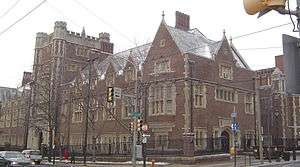
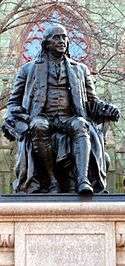


.jpg)